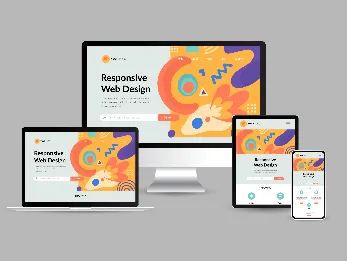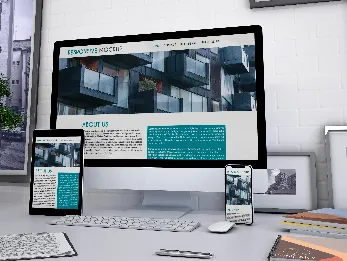Difference Between Web Development & Designing
7 mins | 17 Aug 2023

Table of Contents
1. Introduction
2. Understanding Web Design
3. Understanding Web Development
4. Web Designing and Web Development Difference
5. Web Design and Web Development Collaboration
6. Combining web design vs web development
7. Key Differences Between Web Design and Web Development:
8. Developing a Career in Web Design and Web Development
9. Conclusion
1. Introduction
Websites have grown from being nothing more than platforms for online communication. They have evolved into flexible platforms that connect businesses, individuals, and audiences worldwide. A well-designed website is helpful because it serves as a virtual storefront, a knowledge hub.
The first point of contact for countless interactions. The two main pillars supporting website creation are web design and web development. This comprehensive review will examine the different web design and development areas. They highlight the importance of their productive synergy in the evolution of the online landscape.
What is Web Development?
The complex skill of web developers is found behind the visual attraction of a website. Web developers use coding to help bring design concepts to life and create interactive websites. They use many programming languages to make sure that everything runs.
They shape a website's framework, ensuring responsiveness, functionality, and cross-device compatibility. They understand both the front and back ends of websites or applications. It involves how users interact with the website, and its internal processes handle data.
What is Web Designing?
Web design transforms abstract ideas into visible elements, like a digital artist sketching on paper. Designers create appealing and user-friendly interfaces by combining layout, colour, and user experience principles, seamlessly connecting brands with their audiences.
As we begin this journey, we'll examine the differences between web development and web design.
While both contribute to a common goal, they take different paths to achieve a harmonious result. Each field has its skills, but their collaboration significantly impacts a website's overall success. Examining their roles, responsibilities, and methods uncovers the captivating disparities transforming a concept into an enchanting digital journey.
2. Understanding Web Design
Web design is, at its root, the diligent creativity of arranging various visual components to create an attractive and pleasing user experience. This digital choreography is deeply intertwined with user experience (UX), the cornerstone of user engagement and satisfaction, rather than just superficial aesthetics.
The Initial Choreography:
- Layout Harmony:
Just as a designer creates a building's blueprint, web designers create a website's blueprint. They strategically position elements such as navigation menus, content sections, and call-to-action buttons to ensure intuitive navigation and a balanced visual hierarchy.
- Colour Symphony:
Colours generate emotions, and web designers spreadsheets at conducting this emotional symphony. They select colour palettes consistent with the brand's identity and appeal to the target audience. The interaction of colours promotes cohesion and reinforces the website's intended message.
- The use of fonts:
Elegance The font selection is not haphazard; it is a deliberate decision that enhances the website's personality. Web designers expertly pair fonts for readability and aesthetics, ensuring every word displays an inviting, easy-on-the-eye visual charm.
- Visual Storytelling:
Images bring a website to life; web designers are master storytellers. They create and incorporate images, illustrations, and graphics that complement the content, narrating an enthralling story that visitors find compelling.
- Tools and abilities:
Web designers have assets of design software and tools to help them in their creative endeavours. Adobe Photoshop, Sketch, Figma, and Adobe XD help them realise their visions by allowing them to turn concepts into pixel-perfect realities.
A combination of technical and artistic abilities is required to succeed in web design. Graphic design principles, an eye for detail, a thorough understanding of UX/UI, and the ability to combine disparate visual elements are essential. As designers must translate concepts into accurate design iterations, effective communication and the ability to interpret client or brand requirements are equally important.
3. Understanding Web Development
Web development is the complex process of designing, building, and maintaining websites to ensure they work correctly and provide a meaningful user experience. It consists of two major domains: frontend and backend development. The former oversees the visual presentation and user interactions, while the latter manages the website's backend operations.
The Initial Choreography:
- Coding Symphony:
The art of coding is at the heart of web development. Developers use languages such as HTML, CSS, and JavaScript to create visual frameworks, responsive layouts, and interactive web pages. These languages serve as the foundation for the world of technology.
- Programming Languages:
A web developer's toolkit includes a variety of programming languages, such as Python, Ruby, PHP, and others. These languages enable developers to create complex functionalities, dynamic content, and intricate interactions that improve the user experience of a website.
- Database Dynamics:
Databases are digital warehouses that store and manage website data. Web developers work with database management systems such as MySQL, MongoDB, and PostgreSQL to ensure seamless data retrieval, storage, and manipulation, providing users with accurate and timely information.
- Tools and abilities:
Web developers are the wizards who turn code into user-friendly experiences. They ensure that websites not only look good but also function properly. This includes creating responsive designs that adapt seamlessly to different devices, ensuring that users have the same level of engagement whether on a desktop or a smartphone.
Aside from that, web developers are in charge of integrating third-party APIs, embedding multimedia elements, optimising page loading times, and protecting the website from potential threats. Their watchfulness guarantees a website's health, agility, and longevity in the ever-changing digital environment.
4. Web Designing and Web Development Difference
Responsibilities
Web Designer
Web Developer
Aesthetics and Design
Crafting visual elements, colour schemes, and typography.
Focusing on the technical implementation of website functionality.
User Experience (UX)
Designing layouts for intuitive navigation and engagement.
Ensuring cross-browser compatibility and mobile responsiveness.
Client Collaboration
Collaborating with clients to understand design preferences.
Utilising coding languages like HTML, CSS, JavaScript, etc.
Visual Prototyping
Creating mockups and prototypes using design software.
Handling database management and optimising data flow.
Creativity and Innovation
Infusing creativity to enhance the overall user experience.
Programming interactive elements for dynamic functionalities.
Interface Design
Designing user interfaces that align with brand identity.
Implementing frontend designs that match the visual concept
User-Centric Approach
Prioritising user needs for a seamless and engaging UX.
Ensuring website security and protection against vulnerabilities.
Frontend Development
Collaborating with developers for seamless integration.
Backend development for server-side operations and databases.
Responsive Design
Designing layouts that adapt across various devices.
Employing responsive design techniques for consistent UX.
5. Web Design and Web Development Collaboration
The comfortable collaboration of web designers and developers is the secret ingredient that transforms concepts into captivating online experiences in the fascinating world of website creation.
Like interlinked puzzle pieces, these two fields collaborate to create websites that captivate, function flawlessly, and leave a lasting impression. Let us look at their collaborative symphony and see the power of confers in technology.
Role Interplay: Overlapping and Complementing
- Shared Vision:
The journey begins with the web designer's artistic flair. They weave visual narratives, define user interactions, and craft the overall aesthetics. This serves as the foundation that guides the web developer's technical execution.
- Design-to-Code Transition:
As the designer's vision takes shape, it's the web developer's turn to shine. Armed with coding languages, they breathe life into design mockups, transforming them into functional, interactive elements that users can engage with.
- Responsive Realities:
The collaboration deepens when it comes to responsiveness. While the designer conceptualises layouts that adapt seamlessly across devices, the developer's expertise ensures this vision translates into reality. Together, they guarantee a consistent experience, whether on a desktop, tablet, or smartphone.
- Dynamic Data Integration:
A remarkable website often requires active content integration. The web designer envisions how data will be presented, and the web developer translates this into code, integrating databases and server-side operations to deliver real-time information.
Collaboration between web designers and developers is the link that connects an engaging story in the grand textile of website creation. When their skills, visions, and expertise align, a digital masterpiece blends aesthetics and functionality. Their collaboration improves user experiences and increases user engagement.
It leaves an indelible mark on the digital landscape, from eye-catching visuals to smooth interactions and responsive layouts. As they continue to collaborate, innovate, and inspire one another, the boundaries of digital space expand, promising even more extraordinary websites for us to explore and enjoy.
6. Combining web design vs. web development
Apple's website exemplifies the symbiotic relationship between design and development. Skilled developers bring their designers' sleek aesthetics to life, resulting in a seamless, engaging user experience that aligns with the brand's ethos.
Spotify's website combines captivating design with intricate technicalities. The design team envisions immersive visuals, while developers enable fluid interactions and a responsive layout that adapts to different devices.
Airbnb's interface reflects the collaboration between designers and developers. Developers translate the designers' emphasis on UX into a functional website, ensuring streamlined navigation and a secure booking process.
7. Key Differences Between Web Design and Web Development:
These multiple fields come together to shape the digital landscapes we traverse, yet each has unique features that contribute to our captivating online experiences. Let's go on an adventure to discover the fundamental differences between web design and web development.
Focus and Goals: Aesthetics vs. Functionality
- Web Design:
Web design is a field of design and visual appeal. Designers concentrate on creating visually appealing user interfaces that appeal to visitors. Their primary goal is to create layouts, colour schemes, typography, and imagery that reflect a brand's identity and captivate users, improving user experience (UX) and engagement.
- Web Development:
The field of functionality and performance is web development. Developers are responsible for creating the technical foundations that allow a website to function. Their primary goal is to ensure smooth functionality, optimal performance, and efficient data management, resulting in increased user satisfaction via responsive design, interactive features, and backend operations.
Skill Sets: Creativity vs. Technical Proficiency
- Web Design:
Web designers are creative thinkers who can turn abstract ideas into visually appealing concepts. They have a focused sense of aesthetics, an understanding of design principles, and a command of design software. Graphic design, user interface (UI) design, colour theory, and an intuitive understanding of user psychology are all part of their skill set.
- Web Development:
Web developers are technical architects fluent in coding and the complexities of programming languages. They are proficient in coding languages such as HTML, CSS, JavaScript, and backend languages. Problem-solving, logic, algorithmic thinking, and a thorough understanding of software development principles are all part of their skill set.
Tools and Software: Design Software vs. Coding Languages and Frameworks
- Web Design:
To show their creative visions, web designers use various design software and tools. They can create mockups, prototypes, and visually appealing layouts using software such as Adobe Photoshop, Illustrator, Sketch, and Figma.
- Web Development:
Web developers use coding languages and frameworks to put functionality to the forefront. They use tools such as Integrated Development Environments (IDEs), version control systems, and libraries to write and manage code efficiently. Frontend developers create interactive interfaces with tools like ReactJS, Angular, or Vue.js, while backend developers handle server-side operations with frameworks like Django, Ruby on Rails, or Node.js.
Web design and web development are two parts of the same coin, each contributing its own set of skills to create comprehensive and impactful websites. The interaction of aesthetics and functionality, creativity and technical proficiency, design tools and coding languages, visual appeal and seamless functionality, and visual appeal and seamless functionality culminates in the digital looks that improve our online journeys.
8. Developing a Career in Web Design and Web Development
Starting a career in web design or web development assures an exciting journey. You can shape the digital world by creating visually stunning and functionally seamless experiences with the proper education, skills, and determination.
Whether you're interested in the visual artistry of design or the technical prowess of development, these fields provide a blank canvas for innovation, growth, and limitless possibilities. The opportunities for web designers and developers to leave their mark on the online landscape are endless as the digital realm evolves.
Education, Skills, and Training: Sculpting Expertise
Aspect
Web Design
Web Development
Education
Degree in graphic design, visual arts, or related field; Strong portfolio
Bachelor's degree in computer science, software engineering, or related field; Self-taught with dedication
Skills
Design software proficiency (Adobe Photoshop, Illustrator, Sketch), UI/UX principles, typography, colour theory, artistic eye
Coding language proficiency (HTML, CSS, JavaScript), coding frameworks/libraries, problem-solving, logical thinking
Training
Online courses, workshops, self-guided learning, practical experience (internships, freelance)
Formal education, coding bootcamps, online courses (Codecademy, Udemy), personal projects
Job Opportunities
Design agencies, tech companies, marketing firms, in-house designers
Tech companies, startups, e-commerce platforms, software development firms
Freelance Work
Offering design expertise to clients worldwide
Website creation, app development
Industry Demand
High demand due to businesses' focus on online presence
Strong demand as the digital landscape expands
This table concisely overviews the education, skills, training, job opportunities, freelance work, and industry demand for Web Design and Web Development expertise.
9. Conclusion
The difference between web design and development shows how creativity and technology come together in our digital world. Web design is a creative group that uses colours, layouts, and images to transform ideas into appealing screens that tell a story for users. Designers create online experiences that capture users' attention by combining elements such as how it looks, the colours, the writing, and the images.
At its core, web development is about turning design ideas into working websites. Developers use their coding skills and programming know-how to ensure websites work well. How to make it look good on different devices and keep interactions secure. Their expertise makes websites come alive with changing content and ways for users to interact.
Web designers and developers are close companions, combining creativity and technology. They collaborate to create websites that look great and function, allowing users to enjoy their online experience.
The connection between web design and development continues to impact how we interact, connect, and communicate online. Desiring designers and developers are on their way to a world where innovation prospers, user experiences evolve, and digital landscapes change. It is a world where every line of code and every design element work together to create a digital symphony that connects with users, leaving a permanent imprint on the internet's ever-expanding canvas.
Author

Share
Share
Related

Polymers, Innovation, And A Modern Website: The Goldstab Organics Journey
5 mins : 10 Nov 2025

From Friction to Finish Line: The God of Sports Digital Transformation
6 mins : 17 Sept 2025

The Future Of Responsive Web Design: Emerging Trends, Innovations And Predictions In 2024
7 mins : 26 Apr 2024
Other Articles

Responsive Web Design: Understanding The Basics For Seamless User Experiences
7 mins : 29 Apr 2024

Everything You Should Know About The Ideal Screen Size For Responsive Design
6 mins : 26 Apr 2024

Enhance Your Web Design Creativity with Google Web Designer
4 mins : 17 Nov 2023
